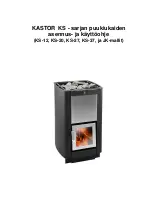
63D4002
13
OPERATION
OPERATION
Do not use a grate or elevate fire. Build wood fire directly on firebrick. When the stove is used
for the first time the solvents in the paint will smoke off.
Wood
This heater is designed to burn natural wood only. Higher efficiencies and lower emissions
generally result when burning air dried seasoned hardwoods, as compared to softwoods or to
green or freshly cut hardwoods.
Only use dry seasoned wood. Green wood, besides burning at only 60 percent of the fuel
value of dry wood, deposits creosote on the inside of your stove and along the chimney. This
can cause an extreme danger of chimney fire. To be called “seasoned,” wood must be dried
for a year. Regardless of whether the wood is green or seasoned, it should be stored in a well-
sheltered ventilated area to allow proper drying during the year to come. Wood should be stored
beyond recommended clearance from combustibles.
Fuel
Even the best stove installation will not perform well with poor fuel. If available, always use
hardwood that has been air-dried (seasoned) 12-18 months. Softwood burns more rapidly than
hardwood and has a high pitch content that can result in creosote. Decayed wood of any type has
little heat value and should not be used.
Unseasoned (green) wood has a high moisture content. Much of its heat value will be used to
evaporate moisture before the wood can burn. This significantly reduces the amount of energy
available to warm your home, as well as the intensity of the fire and temperature of the exhaust
gas. Incomplete combustion and cool flue temperatures promote creosote formation and weak
draft.
You can judge the moisture content of wood by its appearance and weight or use a commercially
available moisture meter for exact measurement. Unseasoned wood will be a third heavier than
dry wood. Also look for cracks (checking) in the ends of the log that result from contraction as the
wood dries. The longer and wider the cracks are, the dryer the wood is.
Creosote
Creosote is a by-product of low-temperature stove operation, weak draft or both. It is a tar
that results when unburned gases condense inside the flue system at temperatures below
290 degrees F. Creosote is volatile and can generate a chimney fire. All of the installation
characteristics that adversely affect chimney draft also promote creosote condensation.
Consequently, you can minimize creosote accumulation with an effective chimney design and the
use of operational techniques that encourage good draft and complete combustion.
Inspect your chimney frequently and clean it whenever accumulation exceeds 1/4".
DO NOT bURN:
Treated Wood, Solvents, Trash, Coal, Garbage, Cardboard, Colored Papers
NEVER USE GASOLINE, GASOLINE-TyPE LANTERN FUEL, kEROSENE, CHARCOAL
LIGHTER FLUID, OR SIMILAR LIQUIDS TO START OR “FRESHEN UP” A FIRE IN THIS
HEATER. kEEP ALL SUCH LIQUIDS WELL AWAy FROM THE HEATER WHILE IT IS IN USE
Summary of Contents for SAVANNAHSSW40
Page 22: ...22 63D4002 NOTES ...










































